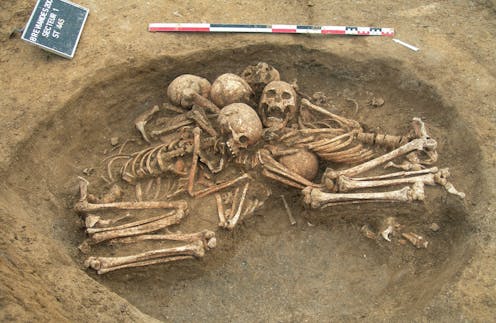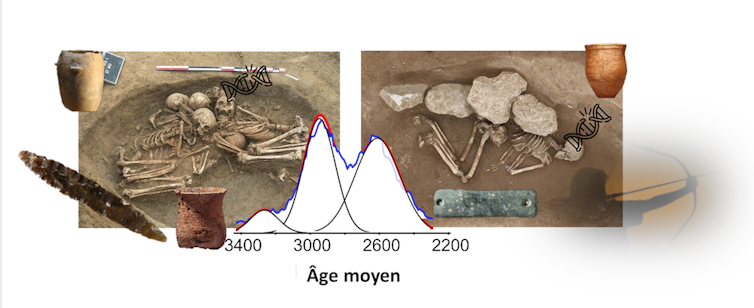
High-resolution analysis of the genomes of individuals buried in a 4,500-year-old collective tomb at Bréviandes-les-Pointes, near the French town of Troyes, has revealed a surprising story with far-reaching implications. As detailed in an article in the journal Science Advances, the final stage in the formation of the European genome is still present in many present-day Europeans.
The human genome is the totality of the genetic information carried by our DNA, and it partially reflects the history of our ancestors. The genome of present-day Europeans was formed over a period of more than 40,000 years as a result of various migrations and the resulting mixing of populations. It is thus made up of the complex heredity of the small populations of hunter-gatherers who occupied Europe until the arrival, around 8,000 years ago, of populations from Anatolia and the Aegean region, who descended from those who invented agriculture and animal domestication in the Fertile Crescent. These Neolithic farmers interbred with the local hunter-gatherers and contributed a very important part of the genome of many of today’s Europeans.
Finally, at the end of the Neolithic 5,000 to 4,000 years ago, nomadic populations from the Pontic steppes (north of the Black Sea stretching from the Danube to the Urals) migrated to Europe and contributed the third of the main genomic components that have endured in Europeans over the following millennia to the present day.
Although today the deciphering – known also as sequencing – of this genetic information is a routine process, this approach remains tricky for the genomes of individuals who lived in the past. All we have left of them are a few more or less fragmented skeletons. Some parts of these skeletons may still contain traces of preserved DNA, but it is fragmented and sparse, which makes it a methodological challenge to analyse.
Our team at the Institut Jacques Monod has taken up this challenge and optimised the methods so that we could obtain reliable results. This enabled us to analyse ancient genomes using the most advanced bioinformatics and statistical methods.
A witness to cross-breeding between populations
Our analyses of the genomes of seven individuals from the Bréviandes tomb, combined with analyses of the morphology of the bones carried out by anthropologists from Inrap, have shown that the tomb held:
A woman who was older than 60 when she died.
her son, an adult man aged around 20-39
her grandson, aged around 4-8
the grandson’s mother, aged 20-39
a young woman aged 20-39
the young woman’s newborn
a child aged between 6-10.
The last three individuals were not related to the others in the grave, and the last child was not related to any of the others. The fathers of the adult man, the newborn baby and the lone child were not present. It was can therefore be surmised that this not the grave of a single biological family. On the other hand, all the female individuals carried a hereditary component characteristic of the populations of southern France and southwestern Europe, and this common origin outside the area of the tomb might explain why they were buried together with their offspring.
In addition, the adult man’s genome was split between the French Neolithic origins of his mother and from his father, the genome of nomadic steppe peoples north of the Black Sea. These nomads migrated to central Europe around 5,000 years ago and interbred with the local Neolithic populations before continuing their migration toward the east, north and northwest of Europe. Within the seven individuals buried in the tomb, we are observing almost in “real time” the introduction of the genome of the steppes nomads into the area’s Neolithic population.
This exceptional situation, which had not previously been described, allowed us to reconstruct the part of the adult man’s genome that he had inherited from his father, who was absent from the grave and therefore could not be directly analysed. The genomic signature of this absent father places his origin in northwestern Europe. We have previously obtained a similar result for another man carrying steppe ancestry, who was buried in the Aisne valley at the same time. These two men could therefore have belonged to the same population.
Because the genomic signature of the adult man’s mother is related to the Neolithic populations of southern France, the Bréviandes tomb therefore bears witness to the encounter in the area of what would be the city of Paris, during the Final Neolithic, between individuals migrating from north to south and back.
Two major waves of interbreeding
Extending the analysis to already published ancient genomes from other European regions has enabled us to model these migrations of steppe peoples. The results suggest that there were two major waves of interbreeding during the 3rd millennium BCE (which begins with year one of our calendar). The first wave of interbreeding was between steppe nomads and Neolithic farmers who created characteristic globular-shaped ceramics with two to four handles. It’s thought to have occurred in Eastern and Central Europe approximately 4,900 years ago.
Their mixed-race descendants developed a new archaeological culture, known as “corded ware”, that takes its name from clay vases that are imprinted with cords before firing. This culture combined elements of the globular amphora culture and steppe cultures, including the burial of the dead in individual tombs. This practice of creating corded ceramics then spread eastwards and northwards in Europe with individuals from the mixed Neolithic-Steppe population. During their migrations from east to west across Europe, these mostly reproduced among themselves rather than with native farming populations.

A second wave of interbreeding with native populations is thought to have occurred 300 to 400 years later in western Europe, some 4,550 years ago. In both cases, the most frequent interbreeding involved migrant men with native women. It was the start of this second wave that we were able to identify in the Bréviandes-les-Pointes tomb.
Thanks to the analysis in the same study of the burial of an adult man at Saint-Martin-la-Garenne (east of Paris), we were also able to show that the interbreeding that occurred played a major role in the transformation of the European genome.
The man was buried according to the funerary rites typical of the Bell-Beaker culture (BBC), with its characteristic bell-like vases found in numerous tombs. This culture developed in western Europe (between the southwest and northwest) before spreading throughout Europe and North Africa. He was buried with a BBC-type shale wrist-guard, an archer’s accessory, which identifies him as having had a high social status. He was of steppe ancestry, and we were able to infer from his genome that his mother carried even more steppe ancestry than he did. This indicates that these populations organised matrimonial networks with groups from other regions whose members had more steppe ancestry. At the end of the Bell-Beaker period around 2000 BC, most of the men analysed carried the Y chromosome of the steppe peoples, which is still the majority among French males today.
The genome of all current Europeans who have lived in Europe for many generations contains, in addition to the Neolithic part, part of this steppe ancestry. This presence is more pronounced in Northern Europe than in Southern Europe.
In conclusion, the two most intense phases of genetic mixing between migrant populations from the steppes and indigenous populations are each associated with the emergence of a new culture, that of the corded ware and of the Bell-Beaker cultures. The latter was the first truly pan-European culture. These encounters and interbreeding would have led to the formation of the genome that is characteristic of many of today’s Europeans.
Oğuzhan Parasayan has received funding through the EUR G.E.N.E. project (reference ANR-17-EURE-0013) and is part of the IdEx project #ANR-18-IDEX-0001 at the University of Paris, both funded by the French government as part of its Investissements d'Avenir Programme.
Eva-Maria Geigl et Thierry Grange ne travaillent pas, ne conseillent pas, ne possèdent pas de parts, ne reçoivent pas de fonds d'une organisation qui pourrait tirer profit de cet article, et n'ont déclaré aucune autre affiliation que leur poste universitaire.
This article was originally published on The Conversation. Read the original article.







